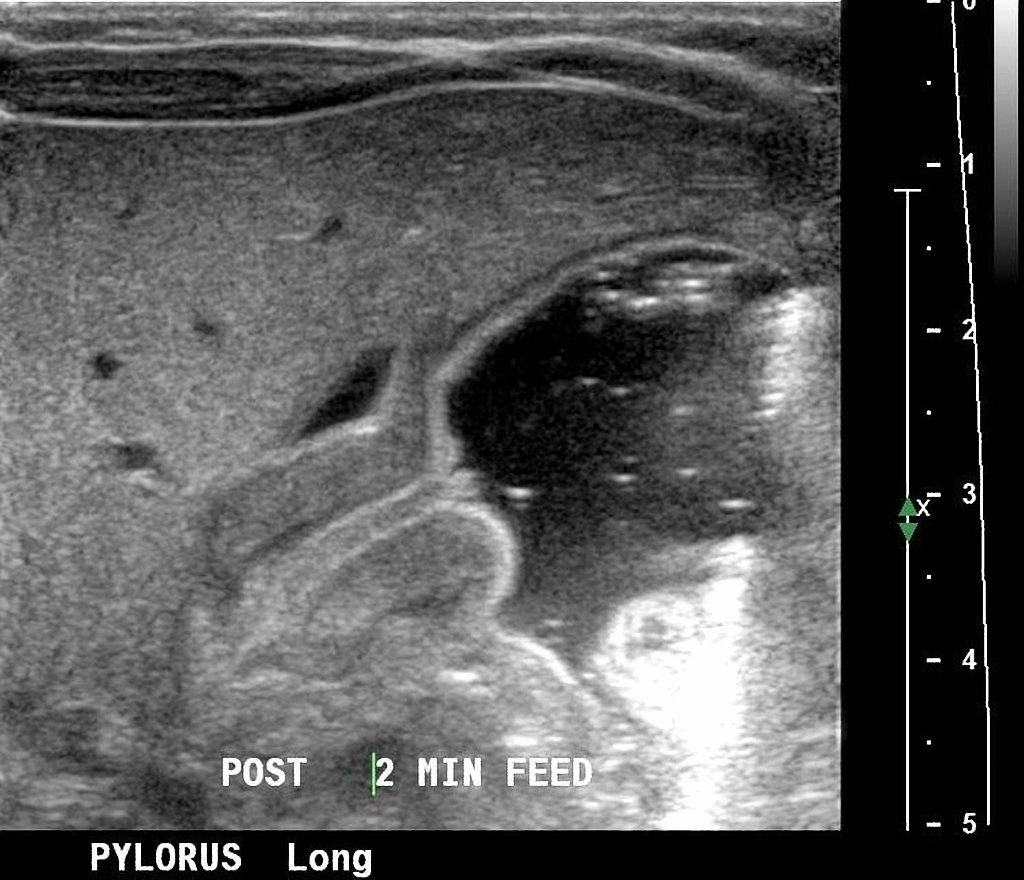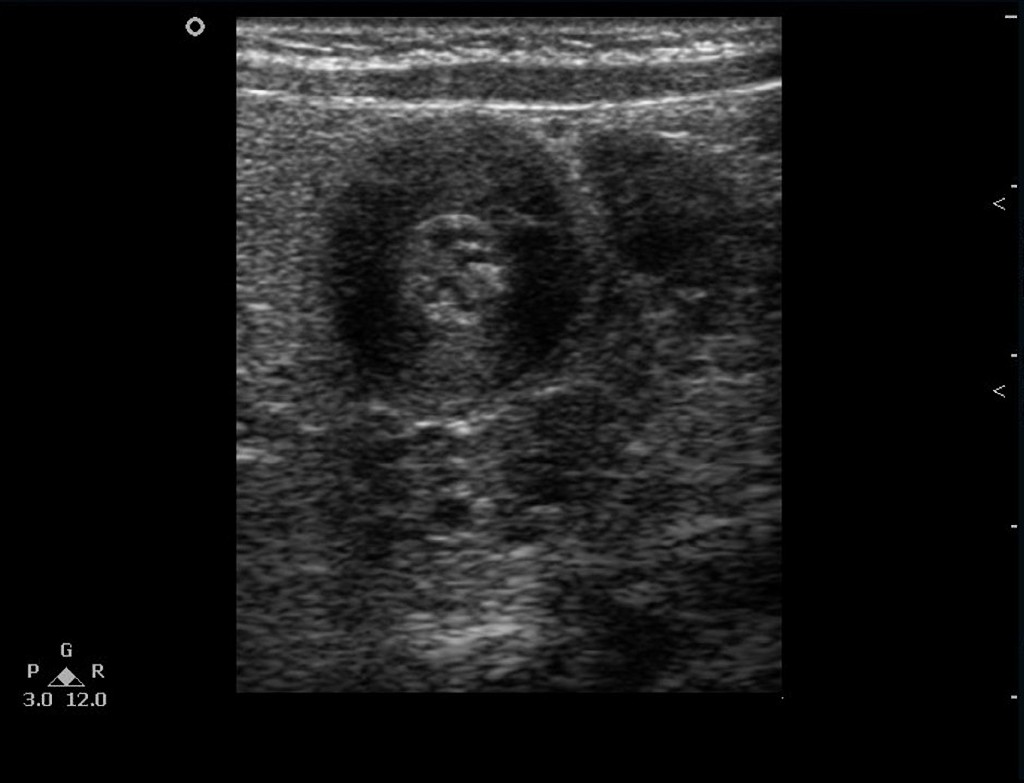Pyloric stenosis ultrasound: Difference between revisions
No edit summary |
No edit summary |
||
| (25 intermediate revisions by 2 users not shown) | |||
| Line 1: | Line 1: | ||
__NOTOC__ | __NOTOC__ | ||
{{Pyloric stenosis}} | {{Pyloric stenosis}} | ||
{{CMG}} {{AE}} {{MMJ}} | {{CMG}}; {{AE}} {{MMJ}} | ||
==Overview== | ==Overview== | ||
[[Ultrasonography]] | [[Ultrasonography]] is the modality of choice for the [[diagnosis]] of infantile pyloric stenosis. The thickened pre-pyloric [[antrum]] bridging the duodenal bulb and distended [[stomach]] could be seen in the [[ultrasound]] of patients with infantile pyloric stenosis. Demonstration of the pylorus is achieved by identifying the [[duodenal]] cap, distended [[stomach]], and intervening pyloric channel. In patients with pyloric stenosis, the variable [[Hypertrophy (medical)|hypertrophy]] of the smooth muscle and crowded intervening mucosa which is thickened to a variable degree, and protrudes into the distended portion of the [[antrum]] '''(nipple sign''') may be observed on [[ultrasonography]]. | ||
==Ultrasound== | ==Ultrasound== | ||
[[Ultrasonography]] is the modality of choice for the [[diagnosis]] of infantile pyloric stenosis.<ref name="pmid22696086">{{cite journal| author=Costa Dias S, Swinson S, Torrão H, Gonçalves L, Kurochka S, Vaz CP et al.| title=Hypertrophic pyloric stenosis: tips and tricks for ultrasound diagnosis. | journal=Insights Imaging | year= 2012 | volume= 3 | issue= 3 | pages= 247-50 | pmid=22696086 | doi=10.1007/s13244-012-0168-x | pmc=3369120 | url=https://www.ncbi.nlm.nih.gov/entrez/eutils/elink.fcgi?dbfrom=pubmed&tool=sumsearch.org/cite&retmode=ref&cmd=prlinks&id=22696086 }} </ref> | |||
*Demonstration of the pylorus is achieved by identifying the duodenal cap, distended [[stomach]], and intervening pyloric channel. | *The thickened pre-pyloric [[antrum]] bridging the duodenal bulb and distended [[stomach]] could be seen in the [[ultrasound]] of patients with infantile pyloric stenosis.<ref name="pmid17966373">{{cite journal| author=Roldán-Valadez E, Solórzano-Morales S, Osorio-Peralta S| title=[Imaging diagnosis of infantile hypertrophic pyloric stenosis: report of a case and review of the literature]. | journal=Rev Gastroenterol Mex | year= 2007 | volume= 72 | issue= 2 | pages= 126-32 | pmid=17966373 | doi= | pmc= | url=https://www.ncbi.nlm.nih.gov/entrez/eutils/elink.fcgi?dbfrom=pubmed&tool=sumsearch.org/cite&retmode=ref&cmd=prlinks&id=17966373 }} </ref> | ||
*Demonstration of the pylorus is achieved by identifying the [[duodenal]] cap, distended [[stomach]], and intervening pyloric channel. | |||
In patients with pyloric stenosis, the following findings may be observed on ultrasonography: | |||
* | *Variable [[Hypertrophy (medical)|hypertrophy]] of the [[smooth muscle]] | ||
*Intervening [[mucosa]] is crowded, thickened to a variable degree, and protrudes into the distended portion of the [[antrum]] '''nipple sign'''<ref name="pmid7602686">{{cite journal| author=Hernanz-Schulman M, Dinauer P, Ambrosino MM, Polk DB, Neblett WW| title=The antral nipple sign of pyloric mucosal prolapse: endoscopic correlation of a new sonographic observation in patients with pyloric stenosis. | journal=J Ultrasound Med | year= 1995 | volume= 14 | issue= 4 | pages= 283-7 | pmid=7602686 | doi= | pmc= | url=https://www.ncbi.nlm.nih.gov/entrez/eutils/elink.fcgi?dbfrom=pubmed&tool=sumsearch.org/cite&retmode=ref&cmd=prlinks&id=7602686 }} </ref> | |||
*Protruded [[mucosa]] may be seen filling the [[lumen]] on transverse sections. | |||
( | * Hypertrophied hypoechoic muscle surrounding echogenic mucosa may be seen in the ultrasound of patients with infantile pyloric stenosis called '''target sign'''.<ref name="pmid21475495">{{cite journal| author=Hussain M| title=Sonographic Diagnosis of Infantile Hypertrophic Pyloric stenosis- Use of Simultaneous Grey-scale & Colour Doppler Examination. | journal=Int J Health Sci (Qassim) | year= 2008 | volume= 2 | issue= 2 | pages= 134-40 | pmid=21475495 | doi= | pmc=3068743 | url=https://www.ncbi.nlm.nih.gov/entrez/eutils/elink.fcgi?dbfrom=pubmed&tool=sumsearch.org/cite&retmode=ref&cmd=prlinks&id=21475495 }} </ref> | ||
[[File:Pyloric_stenosis_nipple_sign_GIF.gif|500px|thumb|left|Ultrasonography showing pyloric stenosis nipple sign [https://radiopaedia.org/articles/antral-nipple-sign source:Case courtesy of Dr Laughlin Dawes , Radiopaedia.org, rID: 8142]]] | |||
<br style="clear:left" /> | |||
[[File:Hypertrophic-pyloric-stenosis-target sign.jpg|500px|thumb|left|Ultrasonography showing pyloric stenosis target sign [https://radiopaedia.org/cases/51340 source:Case courtesy of Dr Hidayatullah Hamidi, Radiopaedia.org, rID: 51340]]] | |||
<br style="clear:left" /> | |||
</ | |||
==References== | ==References== | ||
| Line 27: | Line 26: | ||
{{WH}} | {{WH}} | ||
{{WS}} | {{WS}} | ||
[[Category:Surgery]] | |||
[[Category:Gastroenterology]] | [[Category:Gastroenterology]] | ||
[[Category: | [[Category:Disease]] | ||
[[Category:Pediatrics]] | |||
[[Category:Up-To-Date]] | |||
[[Category:Radiology]] | |||
] | |||
Latest revision as of 19:42, 11 December 2017
|
Pyloric stenosis Microchapters |
|
Diagnosis |
|---|
|
Treatment |
|
Case Studies |
|
Pyloric stenosis ultrasound On the Web |
|
American Roentgen Ray Society Images of Pyloric stenosis ultrasound |
|
Risk calculators and risk factors for Pyloric stenosis ultrasound |
Editor-In-Chief: C. Michael Gibson, M.S., M.D. [1]; Associate Editor(s)-in-Chief: Mohamadmostafa Jahansouz M.D.[2]
Overview
Ultrasonography is the modality of choice for the diagnosis of infantile pyloric stenosis. The thickened pre-pyloric antrum bridging the duodenal bulb and distended stomach could be seen in the ultrasound of patients with infantile pyloric stenosis. Demonstration of the pylorus is achieved by identifying the duodenal cap, distended stomach, and intervening pyloric channel. In patients with pyloric stenosis, the variable hypertrophy of the smooth muscle and crowded intervening mucosa which is thickened to a variable degree, and protrudes into the distended portion of the antrum (nipple sign) may be observed on ultrasonography.
Ultrasound
Ultrasonography is the modality of choice for the diagnosis of infantile pyloric stenosis.[1]
- The thickened pre-pyloric antrum bridging the duodenal bulb and distended stomach could be seen in the ultrasound of patients with infantile pyloric stenosis.[2]
- Demonstration of the pylorus is achieved by identifying the duodenal cap, distended stomach, and intervening pyloric channel.
In patients with pyloric stenosis, the following findings may be observed on ultrasonography:
- Variable hypertrophy of the smooth muscle
- Intervening mucosa is crowded, thickened to a variable degree, and protrudes into the distended portion of the antrum nipple sign[3]
- Protruded mucosa may be seen filling the lumen on transverse sections.
- Hypertrophied hypoechoic muscle surrounding echogenic mucosa may be seen in the ultrasound of patients with infantile pyloric stenosis called target sign.[4]


References
- ↑ Costa Dias S, Swinson S, Torrão H, Gonçalves L, Kurochka S, Vaz CP; et al. (2012). "Hypertrophic pyloric stenosis: tips and tricks for ultrasound diagnosis". Insights Imaging. 3 (3): 247–50. doi:10.1007/s13244-012-0168-x. PMC 3369120. PMID 22696086.
- ↑ Roldán-Valadez E, Solórzano-Morales S, Osorio-Peralta S (2007). "[Imaging diagnosis of infantile hypertrophic pyloric stenosis: report of a case and review of the literature]". Rev Gastroenterol Mex. 72 (2): 126–32. PMID 17966373.
- ↑ Hernanz-Schulman M, Dinauer P, Ambrosino MM, Polk DB, Neblett WW (1995). "The antral nipple sign of pyloric mucosal prolapse: endoscopic correlation of a new sonographic observation in patients with pyloric stenosis". J Ultrasound Med. 14 (4): 283–7. PMID 7602686.
- ↑ Hussain M (2008). "Sonographic Diagnosis of Infantile Hypertrophic Pyloric stenosis- Use of Simultaneous Grey-scale & Colour Doppler Examination". Int J Health Sci (Qassim). 2 (2): 134–40. PMC 3068743. PMID 21475495.